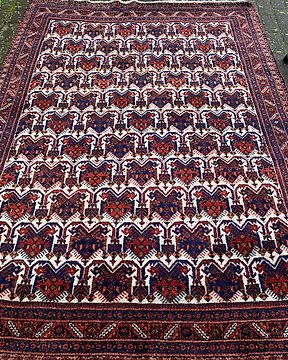
Afszar - Dywan - 160 cm - 220 cm
Nr 83509311

Nr 83509311

Knot density: approx. 200.000 knots/sqm
Pattern: Bakhtiar Medallion
Province: Bakhtiar Iran (Bakhtiari)
Condition: like NEW, freshly washed and sealed with moth repellent and odor eliminator.
Material: pile 100% virgin wool - warp 100% cotton
The Bakhtiari carpet, along with other weaves, is an important art form of the Bakhtiari tribe living in Chahar Mahaal and Bakhtiari in the Iran is resident. Bakhtiari carpets have been exported all over the world since the beginning of the 19th century.
Geography
Although originally knotted by Bakhtiari nomads, most genuine Bakhtiari rugs are made in the sedentary Bakhtiari communities of west-central Iran, southwest of Isfahan, woven in Chahar Mahaal and Bakhtiari and in parts of Isfahan, Lorestan and East Khuzestan provinces, particularly in the city of Shahr-Kurd. Bakhtiari carpets were also known as Saman or Hureh (Hori) after their place of origin. However, Bakhtiari patterns were made in other weaving centers in Iran, in Pakistan, India and China copied; the site-based name often refers to the place of origin of the pattern and the quality of the rug rather than the actual place of manufacture. Saman and hori are now considered qualities of Bakhtiari rugs rather than geographic terms.
Construction
Bakhtiari rugs are based on a cotton base (warp) with a weft of wool, usually taken from the producing tribe's herds. This creates unique carpets that differ according to the characteristics of the wool of each tribe. The wool can range from dull to extremely shiny, and the resulting pile is tailored medium to high. The best carpets with the highest knot density are often referred to as Bibibaff. Prices vary widely, with the rugs with the highest knot density tending to be the most expensive, but price is also influenced by criteria such as the pattern and dyes used. The plays Chapel Shotur and Saman are rated slightly lower than the Bibibaff productions but are still considered good to excellent. The hori rugs are more loosely woven and of lower quality and as such are usually very affordable.
Sizes range from narrow hall rugs to models for large rooms, often measuring up to 4m × 5m. Larger rugs tend to be very rare and harder to find. Likewise, older rugs, which are often coveted by collectors, can be extremely expensive.
Motivs
The patterns are usually inspired by flowers or gardens. A well-established garden pattern, the Khesti is perhaps the best-known carpet pattern. The carpet is divided into individual squares in which animals and plants serve as symbols. Another influential motif shows a field decorated with latticework and floral ornaments.
Colors
The use of colors varies according to the styles of particular tribes. Generally, they include shades of white, red, brown, green, and yellow. Natural dyes lead to color deviations, which are particularly evident in the oldest Bibibaffs.
“Errors and mistakes excepted”
Jak kupować w serwisie Catawiki
1. Odkryj coś wyjątkowego
2. Złóż najwyższą ofertę
3. Dokonaj bezpiecznej płatności